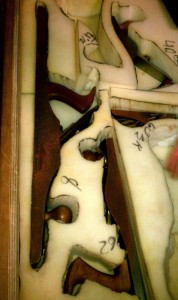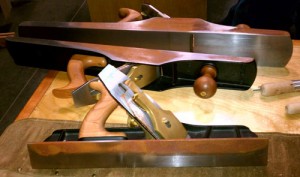Beginning woodworkers can take the flat smooth surfaces on our hand planes and other metal tools for granted. And sometimes the seasoned woodworker can as well. Even with the highly accurate grinding and surfacing that occurs at our factory, it can still seem like a bit of a battle pushing some planes across the wood. At least when compared with the same settings, but adding just a quick swipe of paraffin on the sole. I always advise everyone who is trying the paraffin for the first time to make sure they don’t let the tool get away. The first time I used some paraffin, I thought I was going to send the tool flying off the end of the bench. Friction is the enemy. To this end, prevention of friction, or additional friction, is worth the effort. One thing that can certainly add friction is rust. I’m sure most of you have felt a piece of metal that has rusted. It is usually quite rough.
 Most people know whether or not they live in an area where rust forms quickly. Many times the areas with elevated rust are near a body of water (ocean, lake, pond…), but high humidity alone will facilitate the formation of Mr. Rust. Obviously (or not so obviously), the bodies of planes made from bronze do not rust, even though the blade is still a potential target for rust. This is because rust is iron oxide. The metals used in most non-bronze planes, however, are subject to rust. This includes the blade, which is made from steel. Woodworkers will try a multitude of procedures to ward off rust. In our show kits, we will put Jojoba oil onto a rag (Ed. note: camellia oil also works extremely well), and wipe a liberal amount onto all at-risk surfaces. This usually does an excellent job preventing rust formation. Unfortunately, there can be the rare occasion where even this level of attention is lacking. When we opened up our show kit in Santa Ana California, the tools in the top-most crate were completely covered in rust, but only on the surface facing the lid. And I’m not talking about a few little specs of rust. It looked like the tools had been left out in the rain for weeks, if not months. This kit was in use in Santa Rosa just a week and three days earlier, with no rust. This can be scary, just how fast the heavy rust occurred. Initially we were in shock.
Most people know whether or not they live in an area where rust forms quickly. Many times the areas with elevated rust are near a body of water (ocean, lake, pond…), but high humidity alone will facilitate the formation of Mr. Rust. Obviously (or not so obviously), the bodies of planes made from bronze do not rust, even though the blade is still a potential target for rust. This is because rust is iron oxide. The metals used in most non-bronze planes, however, are subject to rust. This includes the blade, which is made from steel. Woodworkers will try a multitude of procedures to ward off rust. In our show kits, we will put Jojoba oil onto a rag (Ed. note: camellia oil also works extremely well), and wipe a liberal amount onto all at-risk surfaces. This usually does an excellent job preventing rust formation. Unfortunately, there can be the rare occasion where even this level of attention is lacking. When we opened up our show kit in Santa Ana California, the tools in the top-most crate were completely covered in rust, but only on the surface facing the lid. And I’m not talking about a few little specs of rust. It looked like the tools had been left out in the rain for weeks, if not months. This kit was in use in Santa Rosa just a week and three days earlier, with no rust. This can be scary, just how fast the heavy rust occurred. Initially we were in shock.
 When we finally closed our gaping mouths, we got out our ultra-flat granite plate and a couple of maroon Scotch-brite pads. This combination provides enough abrasive to remove the rust quickly, while limiting the hard metal removal. We made sure to retract the blades, but leave them in the planes, under the same tension as when in use. Next we applied controlled elbow grease. I say controlled, since we made sure to keep consistent centralized pressure on whichever side of the plane we were working. If we put pressure onto one edge of plane’s side, there is good chance the flatness of that side would change. This is very similar to the procedure used when sharpening a blade in our honing guide. Centralized pressure results in a square shaped blade, while pressure towards the corners will conversely result in a camber. Strangely enough, even though the rust was covering complete sides of planes, since we’d applied the oil liberally, some of the rust would release when rubbed with a finger.
When we finally closed our gaping mouths, we got out our ultra-flat granite plate and a couple of maroon Scotch-brite pads. This combination provides enough abrasive to remove the rust quickly, while limiting the hard metal removal. We made sure to retract the blades, but leave them in the planes, under the same tension as when in use. Next we applied controlled elbow grease. I say controlled, since we made sure to keep consistent centralized pressure on whichever side of the plane we were working. If we put pressure onto one edge of plane’s side, there is good chance the flatness of that side would change. This is very similar to the procedure used when sharpening a blade in our honing guide. Centralized pressure results in a square shaped blade, while pressure towards the corners will conversely result in a camber. Strangely enough, even though the rust was covering complete sides of planes, since we’d applied the oil liberally, some of the rust would release when rubbed with a finger.
We worked all of the affected planes, until there was no active rust left. A by-product of rusting is metal staining. Even after the brownish-red active rust is gone, usually there will be some signs that rust was there. If the rust is on a surface long enough, it will also cause pitting in the metal. When the metal pits, it also tends to have rough edges around each pit. These rough areas have a tendency to abrade the wood, so it is unlikely a plane in this condition would provide a useful surface. Luckily, we only had one plane that showed any minimal signs of pitting. The lack of more widespread pitting is likely due to both the diligence shown when applying the oil when packing in Santa Rosa, as well as the short duration since the rust began.
So what can be learned from this? Most tools made from iron or an iron compound are at risk of rusting. Another thing, which in my mind is a bit more distressing, is just how quickly the rust formed. And this was on intentionally protected surfaces. If you live in an area, or take your tools to an area that is prime for rusting, elevate your protection measures. This could include wrapping the oiled tools in Ferro-wrap paper, which is treated with a compound inhibiting rust, or using a paste wax directly on the metal surfaces, or buying a dehumidifier for your tool storage area. Additionally some include desiccant packs in with their tools, to absorb moisture. (Ed. Note: We have found Zerust products are also a great solution: check out the drawer liner and the vapor capsules.)
Try some of these techniques to see what works best for you and your area and also check with some of the local long-time woodworkers, to see what they use. Do whatever it takes to keep the tool’s surfaces smooth and rust free. You’ll see the difference.
I hope to see some of you at our upcoming events, listed on the Lie-Nielsen website.
Lee Laird has enjoyed woodworking for over 20 years. He is retired from the U.S.P.S. and works for Lie-Nielsen Toolworks as a show staff member, demonstrating tools and training customers.

